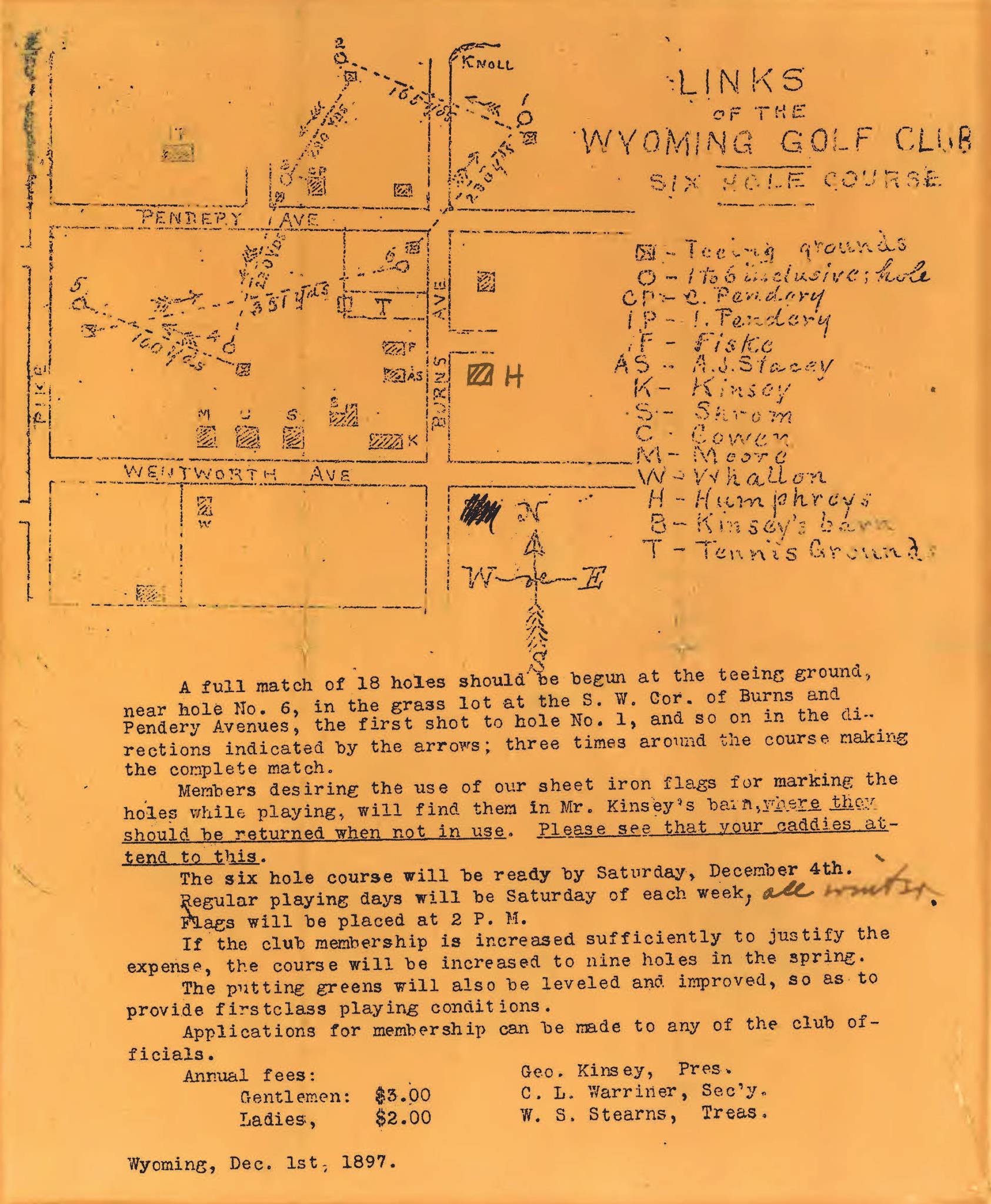Our Story
Cincinnati’s Wyoming Golf Club
grew from a 6-hole neighborhood
course that crisscrossed streets
and wound around houses.
By Frank C. Woodside, III M.D. J.D.
Wyoming, Ohio is a northern suburb of Cincinnati with
a current population slightly in excess of 8,000. Among
Wyoming’s early settlers was the Pendery family, which
arrived in 1805. The Wyoming Golf Club (WGC), a 9-hole
course that traces its history to 1897, is the second oldest
golf club in the greater Cincinnati area. For all but the first
year of its 119-year existence it has been located at 81 Mt.
Pleasant Ave. in Wyoming. It is has been recognized as the
12th best 9-hole course in America (out of 4,600 regulation
nine-hole courses in the country).
The author of this article has a longstanding relationship
with The WGC, first as a caddy, beginning in 1955, and
currently as a member. The author is also a law partner
of John W. Fischer III – the current president of The Golf
Collectors Society. Upon seeing the 1897 “site plan” for the
6-hole course constituting the Links of The Wyoming Golf
Club (which “site plan” will be addressed more fully below)
the Society president immediately declared it to be the type of
“treasure” that should be shared with the GCS membership.
That request served as the impetus for this article. – FCW III
Over time, as improved equipment and balls have
necessitated longer golf courses, the time it
takes to play a traditional 18-hole round also has
increased. Because of changing lifestyles many find it difficult
to find the time to play a full 18 holes. In 2010, Brandon
Tucker, managing editor for Golf Advisor, made a number of
observations:
“Today, 18 holes is the universal norm for a round
of golf. And chances are, unless you’re on vacation or
retired, you probably don’t have time for it – at least not
regularly. …The 18-hole-or-bust standard may well be
one of the main reasons golf is in a state of decline.”
“With time and money a premium these days, more
golf courses are turning to less-than-18-hole layouts.
Courses such Scotland’s Shiskine Golf and Tennis Club
and Toronto’s Derrydale Golf club are thriving with 12
holes.”
Tucker notes, among other things, that courses with 6-hole
“loops” or units have recently been constructed. There also
are campaigns promoting 9-hole courses.
In 2013 Bill Fields reported that Golf Digest, in concert with
the USGA and the PGA of America, was promoting a new
initiative called “Time for Nine,” to encourage shorter rounds
of nine holes that golfers could fit into a busy life style.

Historically there is precedent for designing and building
golf courses with fewer than nine holes as the “loop” or
“unit” of play. In 1951, William B. Langford, president of
the American Society of Golf Course Architects, challenged
the thinking that rounds of 18 holes had to be made up of
Neighborly golf
– since 1897
Cincinnati’s Wyoming Golf Club
grew from a 6-hole neighborhood
course that crisscrossed streets
and wound around houses.
Ninth green in the foreground with the eighth green beyond
at the 9-hole Wyoming Golf Club near Cincinnati, Ohio.
September 2016 17 www.golfcollectors.com
nine-hole “units” when he made the
following statements in support of
courses with six-hole loops:
“While 18 holes constitute a
standard golf course, there is
nothing in the Rules which gives
any official standing to nine holes
as a unit.”
“Limitations of population,
resources or ground frequently
preclude the construction of an
18-hole course, and there is a
general feeling that in such a
case the course built must consist
of nine holes. Tradition does not
support this feeling.”
Thus it is clear that nine or six-hole
courses are an acceptable alternative for
golfers with busy lifestyles so they may
play as little or as much as they desire –
and that this is not a new phenomenon.
That is, it is sanctioned by ancient
history